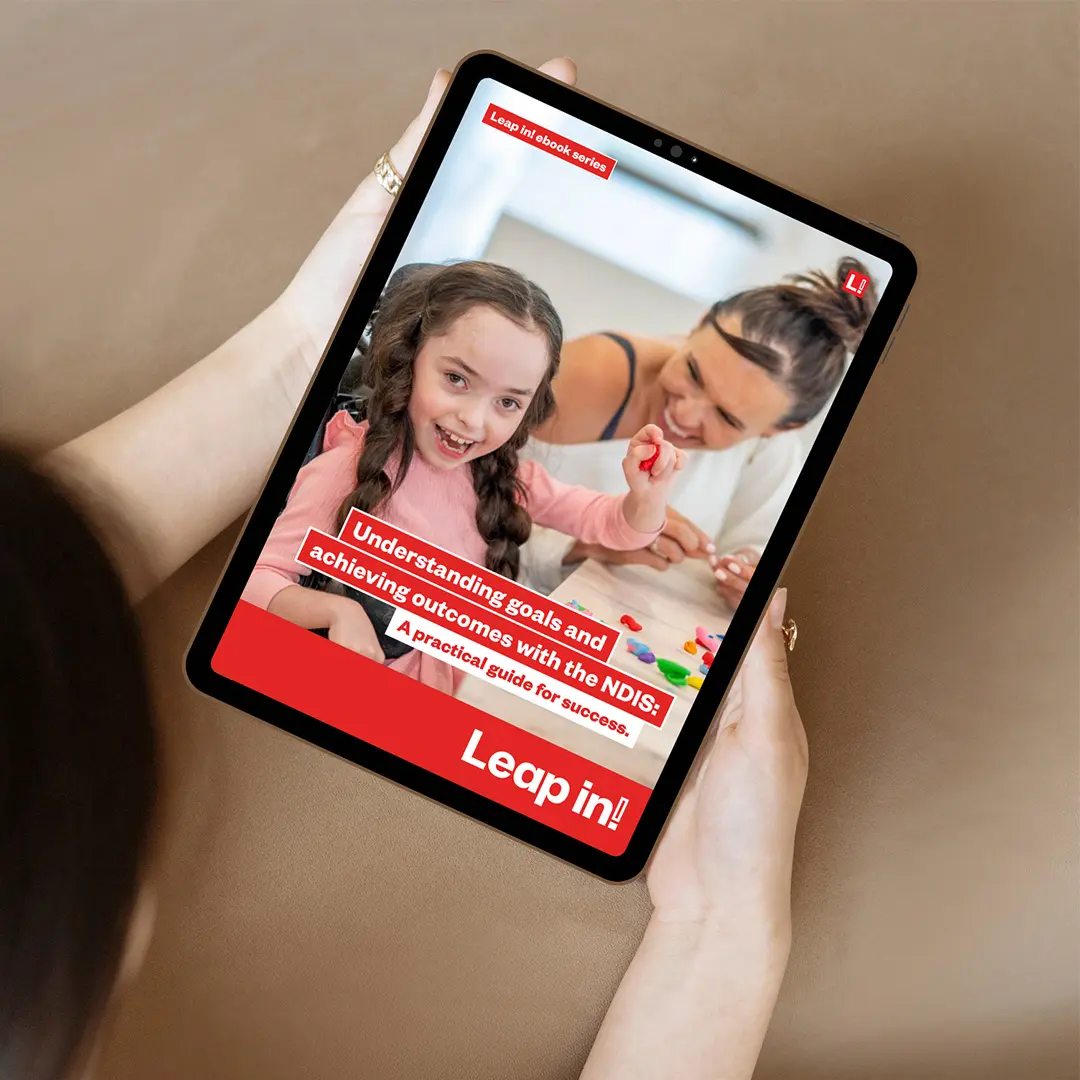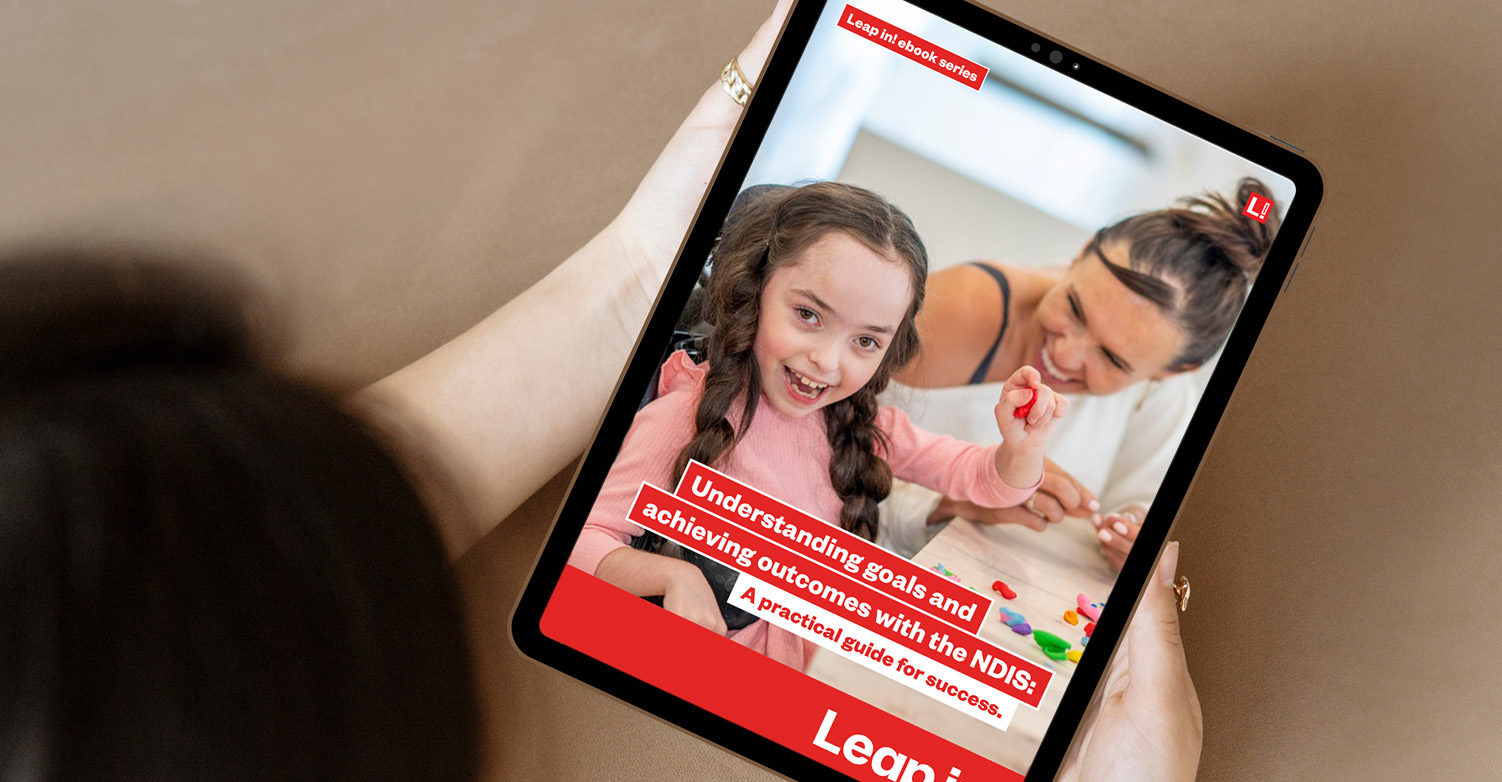NDIS goals: How to set and achieve your goals


Goal-setting is an important part of the NDIS. Setting clear goals as part of your plan meetings means you’re more likely to get the funding you need for supports to help you achieve your goals.
Here, we explore what goals are, why they’re important, and how you can set and track goals to help you make the most of your NDIS Plan. You’ll also find advice for specific life stages.
Whether you’re preparing for your first NDIS plan meeting or have a plan reassessment coming up, this information will help you feel empowered to set the right goals for you.
What are NDIS goals?
NDIS goals are like roadmaps that guide you towards what you want to achieve. Each goal is a statement of intention that provides a clear direction and purpose, helping you stay focused.
These goals give the NDIS information about what’s important to you and what you want to do in life. For an NDIS Plan to be approved, it must include at least one goal. Each goal should include details about the supports that will help you achieve the goal.
NDIS goals should be specific, measurable and usually time-bound which means you’re aiming to achieve each goal in a certain time, such as three months.


“Not having goals is like being at the helm of a boat without a rudder. There is nothing to guide us in the direction we want to go. Working towards a goal that we have thought through and set based on our passions and what we want to achieve is empowering.”
Dr Dinesh Palipana OAM, Leap in! Brand Ambassador.
Goals and your NDIS Plan.
Once your NDIS access request is accepted, you’ll begin to prepare for your first NDIS planning meeting. This is where the NDIS gathers information about you, your goals and any supports you receive to determine what to fund in your plan.
If you already have a plan, reviewing your goals and existing supports is a key part of preparing for your plan reassessment (when you get a new plan).
The better prepared you are going into your NDIS plan meeting or plan reassessment, the higher the chances you will get the right supports for your needs.
Services and supports included in your NDIS Plan may help you pursue your goals and overcome any barriers encountered along the way.


How to get your NDIS goals funded.
- Be clear and specific: Ensure your goals are well-defined and aligned with the NDIS eligibility criteria. Clearly identify goals you want to accomplish and how the supports will benefit you.
- Provide relevant evidence: Include supporting documents, such as medical reports or assessments.
- Understand your funding category: Familiarise yourself with NDIS budget categories and what’s covered under each. Ensure your goals fall within the appropriate category to maximise your chances of approval.
- Work with a support coordinator: Their expertise can help you navigate the NDIS process and support goal setting.
- Be prepared for planning meetings: Prioritise and communicate your goals clearly during planning meetings. Be ready to discuss how the proposed supports align with your needs.
- Explore alternative options: If an initial request for funding is not approved, explore other options, such as Capacity Building funding or support from other government schemes.
- Review your plan regularly: Ensure it accurately reflects your changing needs and goals.
- Seek advocacy support if needed: If you encounter difficulties with getting your goals funded, disability advocacy organisations or support groups may be able to assist.
Every support purchased with NDIS funds must meet the ‘reasonable and necessary’ criteria. For more information, read our article Reasonable and necessary: What it means plus a handy checklist.


Types of NDIS goals.
Most NDIS Plans will have goals that are short-term and medium or long-term. Often the type of goal and the length of time you’ll need to achieve it depends on your age and where you’re at in life.
Short-term goals.
These are goals that you can achieve in a few weeks or a few months. Short-term goals help you make progress and build momentum. If you can achieve your goals in under 12 months, then they’ll be short-term goals.
NDIS goals examples: short-term goal.
- This year, I want to learn to use public transport by myself, so I can go to the library or out with friends and not rely on my Mum
- In the next three months, I want to learn how to shop for, prepare and cook three different meals so I can cook them for my family.
Medium to long term goals.
Longer term goals require more time and effort to accomplish, spanning several months or years. It’s important to identify the steps towards pursuing medium or longer term goals. Breaking larger goals into short-term goals makes them feel more achievable.
NDIS goals examples: medium or long-term goals.
- By Christmas next year, I’d like to have completed my TAFE certificate and be working in a job I enjoy so that I can pay my own bills
- In two years, I want to live independently in an apartment and be confident to manage my household tasks, personal care and finances.
SMART Goals.
The SMART goals process is helpful for people on the NDIS as it allows for clear, measurable and meaningful goal setting. The SMART method has five characteristics.
- Specific: Clearly define your goal and focus on the desired outcome
- Measurable: Work out how to track your progress so you can demonstrate where you started and how you are improving
- Achievable: Set goals that are realistic and achievable for you
- Relevant: Align your goals with your interests, needs and aspirations
- Time-bound: Set a specific timeframe for achieving your goal.
Example of a SMART goal.
By December next year, I will be living independently by developing essential life skills, finding an apartment and accessing necessary support services.


Steps for setting NDIS goals.
Step 1: Think about what’s important to you and how you would like your life to look in the future. For example: “I like participating in activities at my local community centre.”
Step 2: Work out what you might like to improve on or achieve in relation to what’s important to you. If connection with other like-minded people is important to you, you might say “Be more active in my community by attending social activities.” Goals should be written in your own words.
Step 3: Break down each goal into steps. Up to four steps for each goal can be included in an NDIS Plan.
Step 4: Write down the supports you need. Consider any challenges you face and the types of support that may help. Supports may be funded by the NDIS or provided by your family or other organisation.
This information can be shared with your NDIA planner or local area coordinator at your NDIS plan meeting.
8 NDIS goal setting tips.
- Be realistic. It’s easier to stay motivated when your goals are achievable
- Give yourself a timeframe for achieving each goal
- Set goals that align with your interests and strengths
- Break goals into smaller steps
- Reach out to friends, family or support workers for input
- Get a goal buddy, a friend, family member or support worker who can help keep you accountable (plus it’s more fun!)
- Be flexible and open to adjust your goals as circumstances change
- Use the Leap in! app to keep your goal information in one place and in a format that’s ready for your NDIS plan meeting or plan reassessment.
Goal setting for different stages of life.
The national early childhood approach (ECA) provides support to ensure children with developmental delay or disability get the best possible start in life. Early childhood partners (ECPs) are local organisations funded by the NDIS to deliver the early childhood approach.
An ECP understands the unique needs of the child and works with the family to set goals based on the child’s strengths and challenges This could include improving communication skills, enhancing social interactions or developing daily living abilities.
For more details, see The NDIS early childhood approach for children under 9 and A guide to early connections under the early childhood approach.
7 tips for setting your child’s NDIS goals.
- Start with small, achievable goals. Make targets manageable by breaking goals down into steps. This way the child and family can celebrate regular progress.
- Consider the child’s unique abilities, challenges and limitations. Focus on areas where they can make meaningful progress.
- Involve the child in goal setting. Encouraging their active participation can help them understand the purpose of goals and keep them interested.
- Have short and long-term goals in your child’s NDIS Plan. Short-term goals focus on immediate progress and skill building. Long-term goals define a broader vision for the child’s development.
- Collaborate with professionals. Seek input from therapists, teachers and early childhood partners.
- Track and monitor progress through observation, checklists or progress reports. This helps to identify areas that need adjustments or more support.
- See an ECP early. There are waiting lists for child therapy supports in many locations due to a shortage of qualified staff.
Top tip: Consider getting private assessments and diagnosis while receiving early childhood connections. Assessment reports are needed to submit an NDIS access request.
Setting goals during the school years is a powerful tool for supporting children with disability to thrive academically, socially and emotionally.
By working together on your child’s NDIS goals, parents and children can create a roadmap for your child’s life that fosters growth, builds confidence and maximises their potential.
NDIS supports for school-aged children.
For children who have transitioned to the NDIS, it’s helpful to have a clear understanding of relevant NDIS funding supports to align with goals.
- Therapy supports: Includes speech therapy, occupational therapy, physiotherapy and behaviour support.
- Transport: Specialised transport required because of a student’s disability.
- Teacher training: Specialised training for teachers and other staff about the specific personal support needs of a student with disability.
- Specialised equipment and aids: Funding for assistive technology devices and equipment tailored to the specific needs of the child.
- Social and community participation: Supports and activities that promote social and community participation, help children make friends and enhance wellbeing.
- Capacity building: Programs and activities to help the child learn new skills and become more independent.
- Personal care: Assistance with everyday activities, dressing, grooming, toileting and overnight care. Additional self-care at school related to the student’s disability.
- Respite care: Overnight or short-term care offering temporary relief for caregivers and giving your child a change of scenery or opportunity to learn skills in a different environment.
For more details, see Can the NDIS help my child at school?
Goal setting tips for school-aged children.
- Focus on strengths and interests and align goals accordingly.
- Prioritise functional goals that will have a practical impact on the child’s daily life and education.
- Foster a supportive environment that emphasises effort, growth and resilience rather than focusing solely on outcomes.
- Work collaboratively with teachers and therapists to set suitable goals in their NDIS Plan.
- Encourage the child to express their needs, preferences and goals. Include self-advocacy as a goal to improve independence and confidence.
- Consider long-term goals, especially once immediate support needs are met.
Goal setting during this time can also assist with transition preparedness, such as moving to a new grade, changing schools or moving house.
For teenagers and young adults with disabilities, the NDIS goal-setting focus shifts towards preparing for adulthood, independence and a successful transition into post-school life.
There’s so much to think about at this time of life. Setting goals allows young people to have a sense of control over their lives and their future.
NDIS funded supports for teens, tweens and young adults.
There are some supports that may be relevant to consider for teenagers and young people when setting their NDIS goals.
- Developing independent living skills. Goals may focus on skills such as cooking, personal care, managing finances and travelling independently.
- Building vocational skills. Goals may involve vocational training, internships or work experience for a smoother transition to employment.
- Accessing further education: Goals can include researching and applying for higher education or other courses, and developing study skills.
- Community participation and social skills: Goals might involve joining local clubs or groups, developing social networks and participating in recreational activities.
NDIS capacity building supports may also fund things like developing self-advocacy skills, communication training and mentoring to build confidence and independence.
Goal setting tips for teenagers and young adults.
As a young person, it’s important you have the opportunity to actively participate in shaping your own path and have a say in your educational journey. This can enhance both self-esteem and self-confidence.
- Set realistic and meaningful goals that are challenging yet achievable to help you stay motivated.
- Include long-term goals to build planning and decision making skills.
- Align goals with major milestones and transitions such as education, training, employment and independent living.
- Reflect on your achievements to reveal areas where you may want to improve or develop a new skill.
- Identify strengths and how you can use those to overcome barriers or weaknesses to work towards your goals.
- Refine and adapt your goals as circumstances, priorities or aspirations change.
- Learn from past experiences – reflect on what worked well and apply those lessons to set new goals more effectively.
This stage of life involves a lot of change. You may be planning to go from high school to further study or to work. Or you may be currently studying and preparing to enter the workforce for the first time.
Being aware of how the NDIS can assist means you can set goals knowing what support may be available.
NDIS study supports.
Most study supports will come from service providers such as schools, universities and TAFE colleges. The NDIS will only fund supports that are not funded through other programs or services. This may include extra supports you need because of disability or personal care while studying.
Here are some tips for getting your study-related goals funded:
- Include a study-related goal in your NDIS Plan
- Be prepared to talk about your school, university or training provider and any support they give you at your NDIS plan meeting
- Think about additional supports you might need
- Gather together school reports or related assessments
- Get a letter from your place of study outlining any additional disability-related needs.
Going from school or further education to work.
The following general tips can help you start planning for the transition to further education or work while setting your NDIS goals.
- Explore your interests
- Research different career options
- Reflect on your strengths and skills
- Identify potential barriers
- Talk to mentors and teachers
- Research inclusive employers
- Gain some practical experience.
Example NDIS goal and action steps.
Goal: In the next six months, I will actively explore activities, clubs and hobbies that align with my interests. By doing so, I aim to find potential career paths that resonate with my curiosity and passions.
Action steps:
- Research and identify three activities, clubs or hobbies that align with my interests. Attend introductory sessions.
- Actively participate in the activities for at least one month each. Reflect on the aspects of each activity/club that resonate with me the most.
- Work with a career advisor to evaluate how these experiences align with my goals and aspirations.
- Identify two possible career options for further research and organise work experience at each for one week.
See School Leaver Employment Supports for details.
Home and living goals encompass a range of areas related to living arrangements and daily life, including where you live and who you live with, getting around safely at home and day-to-day living.
Setting and achieving home and living goals provides a path for shaping your home environment to meet your needs, be more independent and live the life you want to lead.
Types of goals related to home and living.
Personal care: Goals related to your ability to manage tasks such as bathing, dressing, grooming and eating.
Mobility-related: Goals related to how you move around and navigate the environment with independence.
Your living environment: Covers improving your ability to manage household tasks independently, including cooking, cleaning, laundry and maintaining a safe and accessible living environment.
Where you live and who you live with: Goals may include moving out of the family home, moving in with a flatmate or partner or living on your own.
Financial management. This may include developing skills in budgeting, banking and paying bills
NDIS home and living funding.
If your goal is to live more independently in a home of your NDIS Individualised Living Options may be able to help. ILOs are designed to support people on the NDIS living in a range of situations, like your own home, social housing or a rental property. You may want to live alone, with family, friends or other people with NDIS Plans.
Supported Independent Living is another related type of NDIS funding. SIL may be ideal for an NDIS participant who requires extensive supports to live independently, such as 24/7 personal care, assistance with daily tasks and help to get around. They are commonly funded in shared living environments, with supports shared among residents.
Getting out in the community and making friends is an important part of life. Achieving goals related to being active in society can help create a sense of belonging and connection.
Participating in social activities, neighbourhood groups, sporting groups or the arts is also a great way to learn skills and build confidence.
Types of goals related to social and community participation.
You’ve probably noticed that goals can overlap. For example, social and community activities can be connected to a lot of different goals. Sports activities are a good example. They can help you progress on many goals such as making friends, being more active in the community, building confidence, improving mobility and becoming stronger. You get the idea!
The NDIS has a dedicated funding category for Assistance with Social and Community Participation. It can fund things like support to attend community-based activities and assistance to participate in social groups.
Below are some examples of types of things that this funding category may support.
- Making new friends, meeting new people or expanding your social network
- Learning new things such as through workshops or classes
- Getting fit or trying a new sport which can also help you achieve health related goals
- Arts and cultural experiences such as music lessons, events or festivals
- Advocacy and leadership, such as public speaking skills.
What the NDIS may cover
- Short-term support to build skills to help you participate independently
- Someone to assist with things like finding the right clothes to wear, getting changed or setting you up to join the activity
- Transport to and from the activity if your family can’t provide it and you can’t use public transport independently
- Personal care while you attend an activity, such as assistance to use the bathroom
- Assistive technology, special equipment or equipment modifications to help you participate (eg. a customised bike)
- Training for instructors or coaches to help them understand your needs.
There are many steps on the journey to achieving your career goals. NDIS employment supports cover the entire journey, from preparing for work to getting help on the job to making your next career move.
Why set work-related goals?
- To empower you to make career changes
- Give you a sense of purpose and direction
- Build self-esteem
- Expand your skills, knowledge and expertise
- Motivate you to grow, develop and overcome any barriers you face along the way
- Provide structure for seeking NDIS employment support.
NDIS Workplace assistance.
Workplace assistance is a support designed to build a career pathway and fulfil your career employment goals. It may be used in an open employment setting or with an Australian disability enterprise (ADE).
NDIS Supports in employment – Specialised supported employment.
Supports in employment are designed for employed people on the NDIS who are less independent in performing work tasks. They can also be used to fund additional coaching in the workplace, such as help to stay focused, assistance with communication or job customisation.
NDIS Employment-related assessment and counselling.
Employment-related assessment and counselling sits under the Capacity Building budget in an NDIS Plan. It’s designed to fund services that assist you to successfully engage in employment. For example, helping people who need significant support to return to work after a traumatic injury.
For more details about how the NDIS can help you achieve your employment goals, read NDIS Employment supports: all you need to know.


Where to get help with NDIS goal setting.
Having a knowledgeable guide who understands the NDIS can greatly simplify the goal-setting process and provide valuable assistance.
The right person will be able to explore options with you, make suggestions and help you determine the right goals based on your values, strengths and aspirations.
Local area coordinator (LAC): A LAC can help you create and work towards your goal, make decisions and access the supports you need. They can talk to you about goals and write them down in your own words.
Support coordinator: Can help you identify and describe your goals and the steps to achieve them. They can also explain how to use the supports in your plan and assist with service agreements and bookings.
Allied health professionals: Can provide reports on goals you’ve achieved, identify barriers and how they can be overcome; and conduct assessments to identify your abilities, strengths and areas for improvement. They can also help you break goals into smaller, actionable steps.
Friends and family: People who know you well can provide insights on your strengths, interests and potential areas for growth which can be helpful when setting goals.
Other people in your support network: Talking to other people on the NDIS about their goals, how they record and track them can provide a unique perspective.
Top tip: The Leap in! app is the perfect partner for NDIS goal setting and tracking. It allows you to record your goals somewhere that’s always available and accessible – and track progress along the way.
What to do if your goals change.
Identifying if your goals have changed is an important step in ensuring your plans and aspirations remain aligned. Here are some questions you can ask yourself to work out if you need to change or update your goals.
- Have my circumstances changed?
- Have my interests changed?
- Does looking at my goals make me feel overwhelmed?
- Are barriers or challenges preventing me from making progress towards my goals?
- Do people I trust think that my goals are unrealistic or need tweaking?
If you have answered yes to any of these questions, it may be time to change your goals. Goal updates are a natural part of personal growth and development so don’t be concerned if your goals change. They’re your goals after all!
How to change your goals with the NDIS.
You can change your NDIS goals at any time without changing anything else in your NDIS Plan. The NDIS will update your plan with the new statement of goals and aspirations and send you a varied plan within seven days.
However, if you change your goals and need different supports as a result, you’ll need to ask the NDIS for a plan variation or reassessment which could result in a new plan.
Check out My circumstances have changed: What next? for details.
Reviewing your goals.
Being prepared or your plan meeting or reassessment is the best way to ensure you get the supports you really need.
Spend some time reviewing your goals, current supports and ideal future supports. The Leap in! app has a dedicated section where you can add all the information needed for your meeting so you feel organised and confident.
Some questions to ask yourself:
- Do my goals still meet my current aspirations?
- Do I need to adjust any of my goals due to changes in circumstances or priorities?
- What are the actions or habits that helped me to achieve my goals?
- How close am I to achieving each goal?
- Am I spending all of my NDIS funds?
- Could my NDIS funds go further?
- What barriers are in the way of achieving my goals?
Celebrate your successes.
Celebrating goals is important for confidence and motivation. It reminds you of your capabilities and can give you a big boost.
It’s important to stop and acknowledge your achievements, no matter how small they are. Do something you enjoy, grab your goal buddy or friend and spend some time celebrating you.


Get your Free goals ebook!
Leap in! is excited to launch our latest free ebook designed to help you set and achieve your NDIS goals.
The new ebook, Understanding goals and achieving outcomes with the NDIS: A practical guide for success answers all your goal related questions. We hope you find it helpful.
